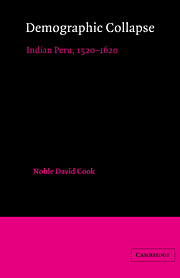Book contents
- Frontmatter
- Contents
- List of tables, figures, and maps
- Preface
- Introduction: The problem in perspective
- Part I Peru's preconquest population
- 1 The ecological approach
- 2 Population and archaeology
- 3 Depopulation ratios
- 4 Estimates from social organization
- 5 Disease mortality models
- 6 Census projections
- 7 Conclusion
- Part II Demographic collapse
- Abbreviations used in notes
- Notes
- Bibliography
- Index
- Titles in the series
5 - Disease mortality models
Published online by Cambridge University Press: 02 December 2009
- Frontmatter
- Contents
- List of tables, figures, and maps
- Preface
- Introduction: The problem in perspective
- Part I Peru's preconquest population
- 1 The ecological approach
- 2 Population and archaeology
- 3 Depopulation ratios
- 4 Estimates from social organization
- 5 Disease mortality models
- 6 Census projections
- 7 Conclusion
- Part II Demographic collapse
- Abbreviations used in notes
- Notes
- Bibliography
- Index
- Titles in the series
Summary
When the isolation of the New World was broken, when Columbus brought the two halves of this planet together, the American Indian met for the first time his most hideous enemy: not the white man nor his black servant, but the invisible killers which those men brought into their blood and breath.
Alfred W. Crosby, Columbian Exchange, P. 31Modern medical researchers are able to project the time, place of appearance, rate of infection, and mortality for disease epidemics. The projections are not completely accurate; nonetheless, predictions of impending outbreaks of potentially dangerous epidemics are taken seriously by public health officials. Indeed, modern disease control is based on the premise of predictability. In this chapter we shall attempt to project a preconquest population figure on the basis of estimated mortality for known epidemics that swept Peru in the sixteenth and early seventeenth centuries.
Numerous complicating factors confront the researcher of early colonial epidemics in America. First, descriptions of epidemics are conflicting. It is often difficult to ascertain the correct disease agent that is called various names by colonial eyewitnesses. Second, the American Indians apparently lacked immunity to common European diseases. Measles, for example, which had a low mortality rate for Old World residents, had very high rates for the virgin American Indian population. Third, general health and diet affected the mortality rate for those who became ill. Warfare, famine, and overwork contributed to the death rate for those who contracted the disease. Fourth, it appears that elevation affected the course and outcome of several types of epidemics. This factor is especially important in the Andes. Fifth, either diseases or humans or both evolved during the century after the first contact.
- Type
- Chapter
- Information
- Demographic CollapseIndian Peru, 1520–1620, pp. 59 - 74Publisher: Cambridge University PressPrint publication year: 1982



